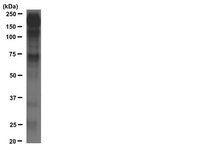PSGL-1-mediated activation of EphB4 increases the proangiogenic potential of endothelial progenitor cells.
Foubert, Philippe, et al.
J. Clin. Invest., 117: 1527-37 (2007)
2007
Show Abstract
Endothelial progenitor cell (EPC) transplantation has beneficial effects for therapeutic neovascularization; however, only a small proportion of injected cells home to the lesion and incorporate into the neocapillaries. Consequently, this type of cell therapy requires substantial improvement to be of clinical value. Erythropoietin-producing human hepatocellular carcinoma (Eph) receptors and their ephrin ligands are key regulators of vascular development. We postulated that activation of the EphB4/ephrin-B2 system may enhance EPC proangiogenic potential. In this report, we demonstrate in a nude mouse model of hind limb ischemia that EphB4 activation with an ephrin-B2-Fc chimeric protein increases the angiogenic potential of human EPCs. This effect was abolished by EphB4 siRNA, confirming that it is mediated by EphB4. EphB4 activation enhanced P selectin glycoprotein ligand-1 (PSGL-1) expression and EPC adhesion. Inhibition of PSGL-1 by siRNA reversed the proangiogenic and adhesive effects of EphB4 activation. Moreover, neutralizing antibodies to E selectin and P selectin blocked ephrin-B2-Fc-stimulated EPC adhesion properties. Thus, activation of EphB4 enhances EPC proangiogenic capacity through induction of PSGL-1 expression and adhesion to E selectin and P selectin. Therefore, activation of EphB4 is an innovative and potentially valuable therapeutic strategy for improving the recruitment of EPCs to sites of neovascularization and thereby the efficiency of cell-based proangiogenic therapy. | Immunoblotting (Western) | Mouse | 17510705
 |
Fc{epsilon}RI-mediated mast cell degranulation requires calcium-independent microtubule-dependent translocation of granules to the plasma membrane.
Nishida, Keigo, et al.
J. Cell Biol., 170: 115-26 (2005)
2005
Show Abstract
The aggregation of high affinity IgE receptors (Fcepsilon receptor I [FcepsilonRI]) on mast cells is potent stimulus for the release of inflammatory and allergic mediators from cytoplasmic granules. However, the molecular mechanism of degranulation has not yet been established. It is still unclear how FcepsilonRI-mediated signal transduction ultimately regulates the reorganization of the cytoskeleton and how these events lead to degranulation. Here, we show that FcepsilonRI stimulation triggers the formation of microtubules in a manner independent of calcium. Drugs affecting microtubule dynamics effectively suppressed the FcepsilonRI-mediated translocation of granules to the plasma membrane and degranulation. Furthermore, the translocation of granules to the plasma membrane occurred in a calcium-independent manner, but the release of mediators and granule-plasma membrane fusion were completely dependent on calcium. Thus, the degranulation process can be dissected into two events: the calcium-independent microtubule-dependent translocation of granules to the plasma membrane and calcium-dependent membrane fusion and exocytosis. Finally, we show that the Fyn/Gab2/RhoA (but not Lyn/SLP-76) signaling pathway plays a critical role in the calcium-independent microtubule-dependent pathway. | Activation Assay | | 15998803
 |
Heavy and light chain variable region sequences and antibody properties of anti-phosphotyrosine antibodies reveal both common and distinct features.
Ruff-Jamison, S, et al.
J. Biol. Chem., 266: 6607-13 (1991)
1991
Show Abstract
Phosphotyrosine and similar analogs have been used to elicit antibodies that have found widespread use in the study of cellular tyrosine phosphorylation. In order to better understand the anti-phosphotyrosine immune response and to elucidate the details of the specific association between a tyrosine phosphate and an antibody combining site, we have undertaken a detailed comparison of antibody stability, specificity, apparent affinity, and primary structure for eight different anti-phosphotyrosine antibodies derived from immunizations with three different antigens. Two of these, 2G8 and 1G2, were derived from an immunization using azobenzylphosphonate conjugated to carrier, and five others, Py2, Py20, Py42, Py54, and Py69, were the products of an immunization with phosphotyrosine conjugated to carrier. Each of these anti-hapten antibodies was an IgG. One antibody, 129, an IgM, was the result of an immunization with a mixture of tyrosine-phosphorylated proteins which had been purified from growth factor treated cells. We found that antibody binding was significantly inhibited by millimolar levels of divalent cations or high concentrations of monovalent salt, with the exception of the antibody 129 where binding was significantly enhanced by both. Under optimal conditions, the highest apparent affinities for phosphotyrosine were observed for antibodies Py69 and Py20 (10(-6)-10(-7) M) and the lowest for 129 and 1G2 (10(-3)-10(-4). The heavy and light chain variable regions of seven of these antibodies were cloned and sequenced and a predominant anti-phosphotyrosine response was observed. The light chains of these antibodies could be assigned to one of two major VK groups, VK10 and VK19, with sequence identity between the different light chains of each class ranging from 65 to 100% at the amino acid level. Similar sequence identity was found among the heavy chain sequences (89-98% identity at the amino acid level) with the exception of one antibody, 2G8, which was only distantly related to the others (61-64% amino acid identity). These heavy chains belong to the same heavy chain family, J558. Two of the antibodies, Py20 and Py69, were clearly derived from the same progenitor cell since both share a highly unusual apparent V-D-D-JH organization. However, a significant level of somatic mutation has occurred between the two antibodies resulting in subtle changes in their apparent affinity and specificity. | | | 1706720
 |












